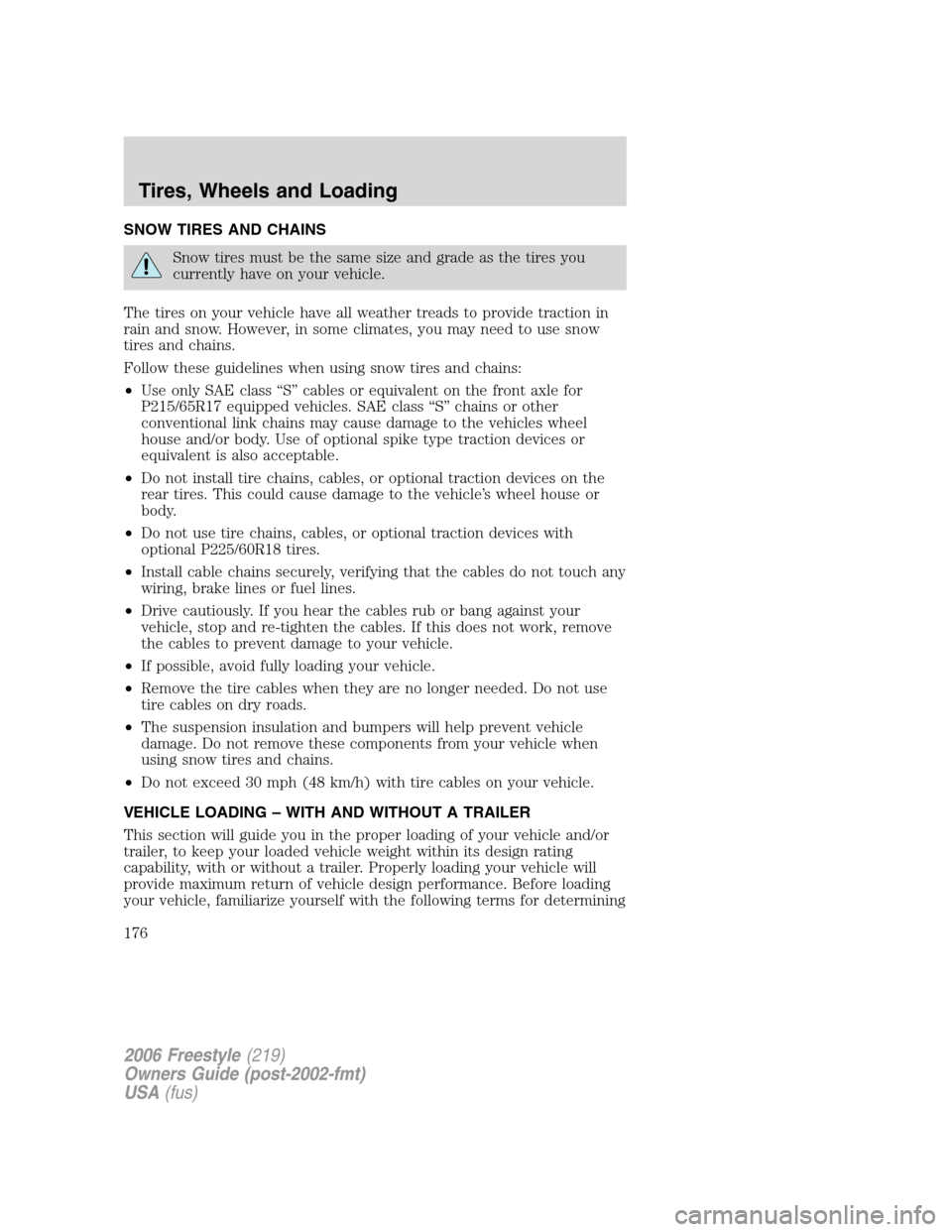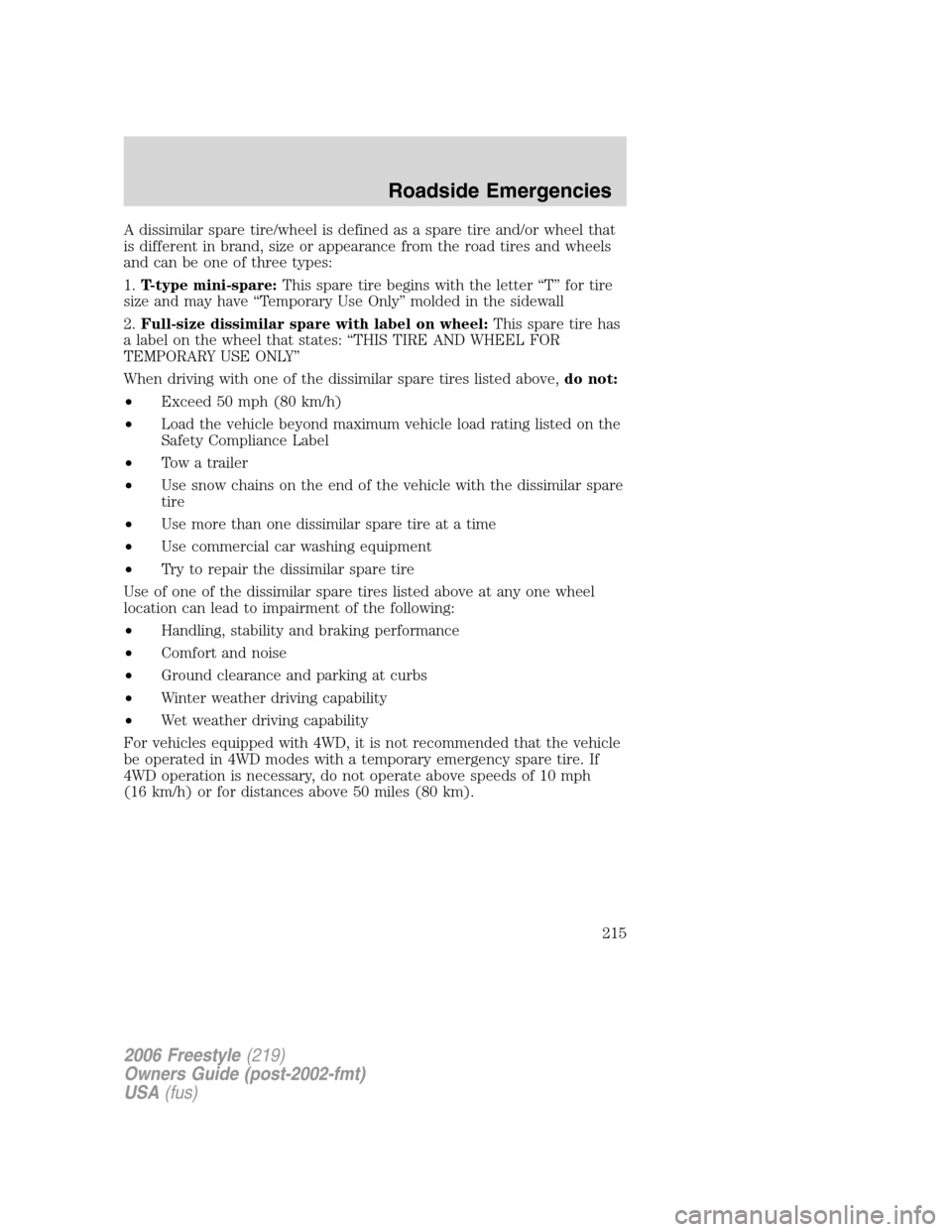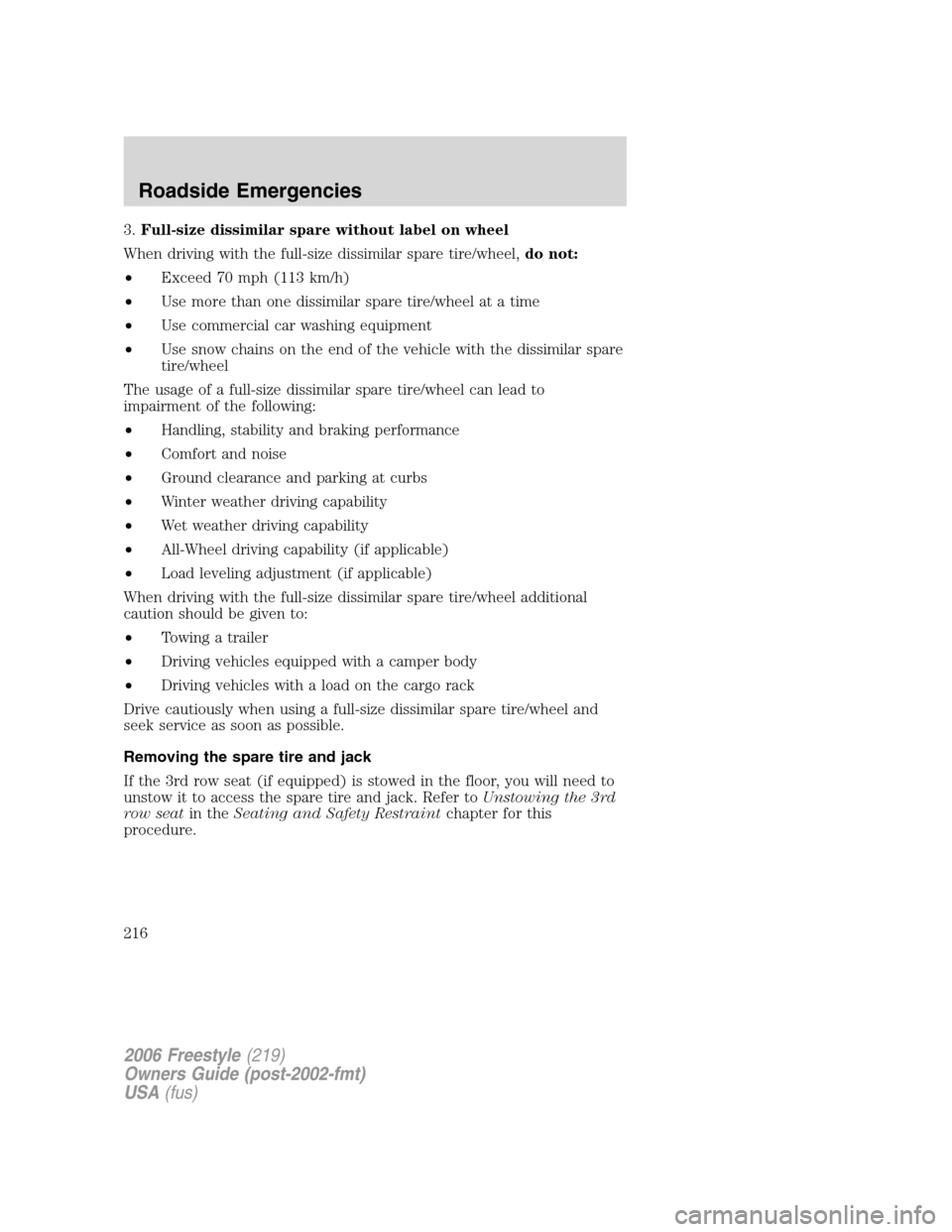2006 FORD FREESTYLE snow chains
[x] Cancel search: snow chainsPage 176 of 288

SNOW TIRES AND CHAINS
Snow tires must be the same size and grade as the tires you
currently have on your vehicle.
The tires on your vehicle have all weather treads to provide traction in
rain and snow. However, in some climates, you may need to use snow
tires and chains.
Follow these guidelines when using snow tires and chains:
•Use only SAE class “S” cables or equivalent on the front axle for
P215/65R17 equipped vehicles. SAE class “S” chains or other
conventional link chains may cause damage to the vehicles wheel
house and/or body. Use of optional spike type traction devices or
equivalent is also acceptable.
•Do not install tire chains, cables, or optional traction devices on the
rear tires. This could cause damage to the vehicle’s wheel house or
body.
•Do not use tire chains, cables, or optional traction devices with
optional P225/60R18 tires.
•Install cable chains securely, verifying that the cables do not touch any
wiring, brake lines or fuel lines.
•Drive cautiously. If you hear the cables rub or bang against your
vehicle, stop and re-tighten the cables. If this does not work, remove
the cables to prevent damage to your vehicle.
•If possible, avoid fully loading your vehicle.
•Remove the tire cables when they are no longer needed. Do not use
tire cables on dry roads.
•The suspension insulation and bumpers will help prevent vehicle
damage. Do not remove these components from your vehicle when
using snow tires and chains.
•Do not exceed 30 mph (48 km/h) with tire cables on your vehicle.
VEHICLE LOADING – WITH AND WITHOUT A TRAILER
This section will guide you in the proper loading of your vehicle and/or
trailer, to keep your loaded vehicle weight within its design rating
capability, with or without a trailer. Properly loading your vehicle will
provide maximum return of vehicle design performance. Before loading
your vehicle, familiarize yourself with the following terms for determining
2006 Freestyle(219)
Owners Guide (post-2002-fmt)
USA(fus)
Tires, Wheels and Loading
176
Page 215 of 288

A dissimilar spare tire/wheel is defined as a spare tire and/or wheel that
is different in brand, size or appearance from the road tires and wheels
and can be one of three types:
1.T-type mini-spare:This spare tire begins with the letter “T” for tire
size and may have “Temporary Use Only” molded in the sidewall
2.Full-size dissimilar spare with label on wheel:This spare tire has
a label on the wheel that states: “THIS TIRE AND WHEEL FOR
TEMPORARY USE ONLY”
When driving with one of the dissimilar spare tires listed above,do not:
•Exceed 50 mph (80 km/h)
•Load the vehicle beyond maximum vehicle load rating listed on the
Safety Compliance Label
•Tow a trailer
•Use snow chains on the end of the vehicle with the dissimilar spare
tire
•Use more than one dissimilar spare tire at a time
•Use commercial car washing equipment
•Try to repair the dissimilar spare tire
Use of one of the dissimilar spare tires listed above at any one wheel
location can lead to impairment of the following:
•Handling, stability and braking performance
•Comfort and noise
•Ground clearance and parking at curbs
•Winter weather driving capability
•Wet weather driving capability
For vehicles equipped with 4WD, it is not recommended that the vehicle
be operated in 4WD modes with a temporary emergency spare tire. If
4WD operation is necessary, do not operate above speeds of 10 mph
(16 km/h) or for distances above 50 miles (80 km).
2006 Freestyle(219)
Owners Guide (post-2002-fmt)
USA(fus)
Roadside Emergencies
215
Page 216 of 288

3.Full-size dissimilar spare without label on wheel
When driving with the full-size dissimilar spare tire/wheel,do not:
•Exceed 70 mph (113 km/h)
•Use more than one dissimilar spare tire/wheel at a time
•Use commercial car washing equipment
•Use snow chains on the end of the vehicle with the dissimilar spare
tire/wheel
The usage of a full-size dissimilar spare tire/wheel can lead to
impairment of the following:
•Handling, stability and braking performance
•Comfort and noise
•Ground clearance and parking at curbs
•Winter weather driving capability
•Wet weather driving capability
•All-Wheel driving capability (if applicable)
•Load leveling adjustment (if applicable)
When driving with the full-size dissimilar spare tire/wheel additional
caution should be given to:
•Towing a trailer
•Driving vehicles equipped with a camper body
•Driving vehicles with a load on the cargo rack
Drive cautiously when using a full-size dissimilar spare tire/wheel and
seek service as soon as possible.
Removing the spare tire and jack
If the 3rd row seat (if equipped) is stowed in the floor, you will need to
unstow it to access the spare tire and jack. Refer toUnstowing the 3rd
row seatin theSeating and Safety Restraintchapter for this
procedure.
2006 Freestyle(219)
Owners Guide (post-2002-fmt)
USA(fus)
Roadside Emergencies
216
Page 285 of 288

Relays ........................................207
Remote entry system .................92
illuminated entry ................96–97
Reverse sensing system ...........196
Roadside assistance ..................205
Roof rack .....................................89
S
Safety Belt Maintenance ..........131
Safety belts
(see Safety restraints) ............118,
122–125
Safety Canopy ...........................144
Safety defects, reporting ..........235
Safety restraints ........118, 122–125
belt minder .............................126
extension assembly ................131
for adults .........................123–125
for children .............................147
Occupant Classification
Sensor ......................................120
safety belt maintenance .........131
warning light and chime ........126
Safety seats for children ..........151
Safety Compliance
Certification Label ....................276
Seat belts
(see Safety restraints) .............118
Seats ..........................................105
child safety seats ....................151
front seats ...............105–106, 109
heated ............................44, 46, 49
memory seat .....................93, 110
second row seats ............111, 114
third row seats ........114, 116–117
Servicing your vehicle ..............242Setting the clock
AM/FM/In-dash 6 CD ................21
Spare tire
(see Changing the Tire) ...........216
Spark plugs, specifications ......269,
274
Specification chart,
lubricants ...........................272, 274
Speed control ..............................70
Starting your vehicle ........186–188
jump starting ..........................222
Steering wheel
controls ......................................73
tilting .........................................62
T
Tilt steering wheel ......................62
Tires ...........................161–162, 214
alignment ................................168
care ..........................................166
changing ..................214, 216–217
checking the pressure ............166
inspecting and inflating .........163
label .........................................175
replacing ..................................170
rotating ....................................168
safety practices .......................167
sidewall information ...............170
snow tires and chains ............176
spare tire .................................214
terminology .............................162
tire grades ...............................162
treadwear ........................161, 166
Towing .......................................182
recreational towing .................185
trailer towing ..........................182
wrecker ....................................227
Traction control ........................192
2006 Freestyle(219)
Owners Guide (post-2002-fmt)
USA(fus)
Index
285